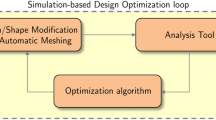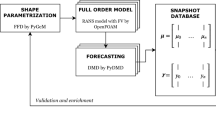Abstract
The practical use of automated computational fluid dynamics (CFD)-based design tools in the ship-building industry requires powerful flow solvers which are able to take into account realistic geometries as well as complex physical phenomena, such as turbulence. A shape optimization tool is developed in this framework. A derivative-free optimizer, yielding both flexibility and robustness, is preferred to the classical gradient-based method, which is more difficult to implement and is still limited to only moderately complex problems. The flow solver included in the design procedure solves the incompressible Reynolds-averaged Navier–Stokes equations on unstructured grids using a finite-volume formulation involving several near-wall low-Reynolds-number turbulence models. The design tool is used to optimize the stern of a modern hull shape at model and full scale, with different purposes being considered. More precisely, the drag reduction and the homogenization of the flow in the wake are expected by controlling the longitudinal vortex generated. Our interest is particularly focused on the influence of turbulence modeling in the design process. The effects of a two-equation model based on the eddy-viscosity assumption and a second-order closure relying on the Reynolds stress transport equations are compared.
Similar content being viewed by others
Author information
Authors and Affiliations
Additional information
Received: September 24, 2002 / Accepted: April 14, 2003
RID="*"
Acknowledgment. The authors thank the scientific committee of CINES (project dmn2050) for the attribution of CPU time.
About this article
Cite this article
Duvigneau, R., Visonneau, M. & Deng, G. On the role played by turbulence closures in hull shape optimization at model and full scale. J Mar Sci Technol 8, 11–25 (2003). https://doi.org/10.1007/s10773-003-0153-8
Issue Date:
DOI: https://doi.org/10.1007/s10773-003-0153-8




